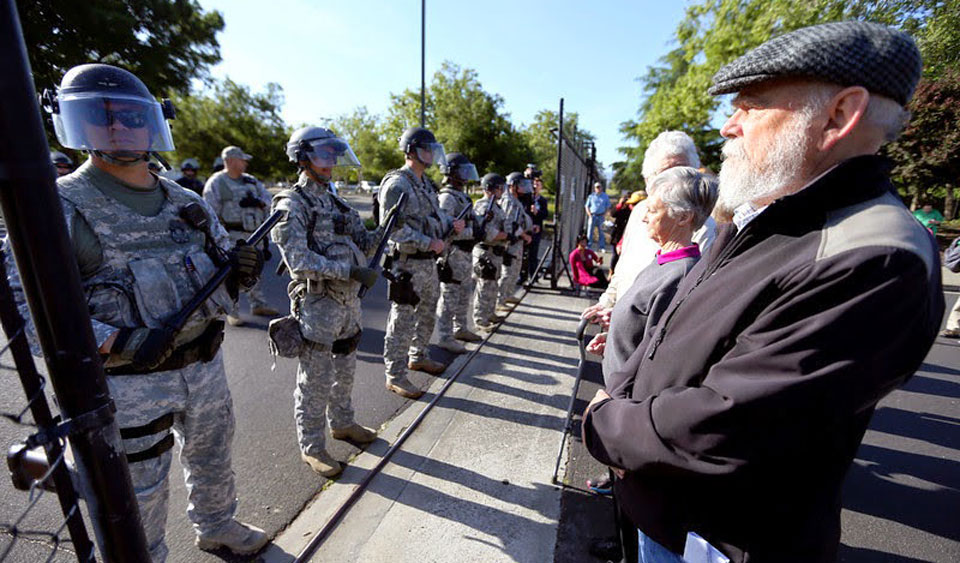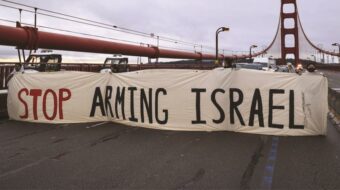
LIVERMORE, Calif.—As the world observed the 75th anniversaries of the U.S. atomic bombings of Hiroshima and Nagasaki on Aug. 6 and 9, 1945, a virtual rally focusing on the Lawrence Livermore National Laboratory here kicked off two days of nationally broadcast virtual programming put together by over 160 peace and disarmament organizations under the auspices of the Hiroshima Nagasaki 75 collaboration.
The programming shown on the two anniversary dates can be viewed here.
The Livermore protest, “From Hiroshima to a Healthy Tomorrow: Embracing our Common Humanity,” brought together national and San Francisco Bay Area leaders in the fight to abolish nuclear weapons forever. Throughout the program, speakers addressed the urgent need for popular mobilization to end the growing threat posed by nuclear weapons and to shift resources to human needs and economic and social justice.
Marylia Kelley, executive director of Tri-Valley Communities Against a Radioactive Environment (Tri-Valley CAREs), stood outside the Livermore Lab’s fence as she opened the program, telling participants from around the country that the lab, on the outskirts of the San Francisco Bay Area, is one of the two U.S. national laboratories that design every nuclear weapon in the U.S. stockpile.
As an image of the lab’s budget chart appeared on the screen, Kelley pointed out that nearly 90% of the over-$2 billion requested for 2020-21 is allocated to nuclear weapons while less than 2% is for civilian science.
“We are in the belly of the beast that is developing new warheads,” she said. Among current projects: two new nuclear weapons, the W80-4, destined to sit atop a new air-launched cruise missile that can be launched thousands of miles from its unsuspecting target, and the W87-1, a new intercontinental ballistic missile warhead that will need a plutonium bomb core unlike anything in the stockpile or in storage.
Meanwhile, Kelley said, the Trump administration is seriously discussing resuming nuclear weapons tests after a break of over 25 years.
“In this time of COVID, on this 75th anniversary of our country’s atomic bombings of Hiroshima and Nagasaki,” she said, “this is our government’s priority. This is what we must change.”
The Rev. Nobuaki Hanaoka, a retired Methodist minister living in the Bay Area for many years, was an eight-month-old infant living on the outskirts of Nagasaki when that city was struck.
His father moved the family to another city, but Hanaoka said he always remembered his mother and older sister as pale, weak, and bedridden with the leukemia that soon took their lives. As a child, he overheard a physician say he himself might not reach his tenth birthday.
“Mr. President,” Hanaoka said, “if you want a Nobel Peace Prize, invite the nine nuclear weapons states to the negotiating table, and negotiate with them to start dismantling the weapons of the devil, the weapons of global annihilation. That is what a president could do now.”
Historian and political economist Gar Alperowitz, author of two major studies on the decision to bomb Hiroshima, called Aug. 6, 1945 “a day of infamy,” adding that “virtually every top diplomatic and military person within the upper ranks of the American government knew the bombings were unnecessary to end the war without an invasion and massive loss of life.” In fact, Adm. William D. Leahy, chair of the Joint Chiefs of Staff, said the bombings were “of no material assistance” in the war against Japan, and said that by being the first to use it, the U.S. had adopted a “barbarian” ethical standard.
Rather, Alperowitz said, use of the bomb appears to have been intended more to challenge the Soviet Union.
“The lesson here,” Alperowitz said, “is that not only are nuclear weapons dangerous, but leaders are not to be trusted with these weapons. We’ve been very lucky for 75 years, but when these weapons are in the hands of a man like President Trump, we do not know what will happen.
“The only activity that can possibly stop and prevent the next war, which could be a nuclear war, is citizen action.”
Daniel Ellsberg, the whistleblower whose 1971 release of the Pentagon Papers helped speed the end of the Vietnam War, noted that U.S. efforts to use the bomb as a warning to the USSR, possibly rolling back their role in Eastern Europe, “failed to do that, nor did we achieve a monopoly on the bomb. At the height of the arms race that ensued, the world saw 70,000 nuclear weapons in existence in the U.S. and USSR.
“This is not a species to be trusted with nuclear weapons,” Ellsberg said. Calling their continued existence “a constant risk to most humans, and many other species, on earth,” he declared that we must “reverse this process … take this out of the hands of the leaders who have put us in this position, and act for our species’ survival.”

As Jackie Cabasso, executive director of the Western States Legal Foundation and North American Coordinator for Mayors for Peace, told the virtual crowd in presenting the rally’s Call to Action, “On this 75th anniversary, we gather virtually at the Livermore Lab to say ‘Never Again!’ to the use of nuclear weapons, to demand a halt to their modernization, to call for their global abolition, and to demand the redirection of human and financial resources to health care, racial and economic equality, environmental protection, and peace. We are here to visualize moving from Hiroshima to a healthy tomorrow, embracing our common humanity.”
Nearly 14,000 nuclear weapons exist today, Cabasso said, most far more powerful than those 75 years ago and over 90% of them in the hands of the U.S. and Russia. All the nuclear-armed countries are in the process of modernizing their weapons, with the U.S. poised to spend nearly $2 trillion over the next three decades to maintain and modernize its arsenal.
Adding to the danger are the increased scale and tempo of war games by nuclear-armed states and their allies, including nuclear weapons drills, together with ongoing missile tests and frequent close encounters between military forces of nuclear-armed states.
Cabasso told the virtual crowd, “Let us work together to understand the common causes of our current multifaceted crisis as we work … with others to build the massive multigenerational, multiracial, moral fusion movement we will need to overcome systemic state violence and build a peaceful, just, sustainable, and inclusive world.”












Comments